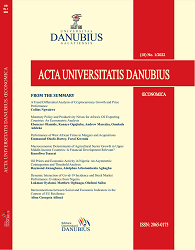Exchange Rate Misalignment and Monetary Policy Reaction in Nigeria
Exchange Rate Misalignment and Monetary Policy Reaction in Nigeria
Author(s): Olaoluwa Ige, Adebayo Sunday Adedokun, Adewumi OtonneSubject(s): Business Economy / Management, Labor relations, Economic policy, International relations/trade, Economic development
Published by: Editura Universitară Danubius
Keywords: Output gap; Inflation; Taylor rule; GMM; 2SLS;
Summary/Abstract: The study examined the effect of the exchange rate misalignment on monetary policy reaction in Nigeria. Specifically, the study examined how the monetary policy rate responds to exchange rate misalignment using monthly data from January 2011 to June 2020. The study augmented the Taylor policy rule by incorporating the exchange rate misalignment variable. The study employed the generalised method of moments and two-stage least square estimation techniques for its analysis. The results show that the monetary authority targets price stability in formulating monetary policy in Nigeria, with lesser consideration for exchange rate misalignment and output gaps. This implies that exchange rate misalignment has a negligible effect on the conduct of monetary policy in Nigeria. Instead, monetary policy reacts more to the rate of inflation. Thus, the study recommends that the monetary authority pay considerable attention to exchange rate misalignment and the output gap, given their capacity to induce inflationary or deflationary pressures on the economy. The study underscores the fact that the high output gap and continuous misalignment of the exchange rate to its long-run equilibrium that is not addressed would eventually render the monetary policy thrust ineffective.
Journal: Acta Universitatis Danubius. Œconomica
- Issue Year: 18/2022
- Issue No: 1
- Page Range: 136-152
- Page Count: 17
- Language: English

